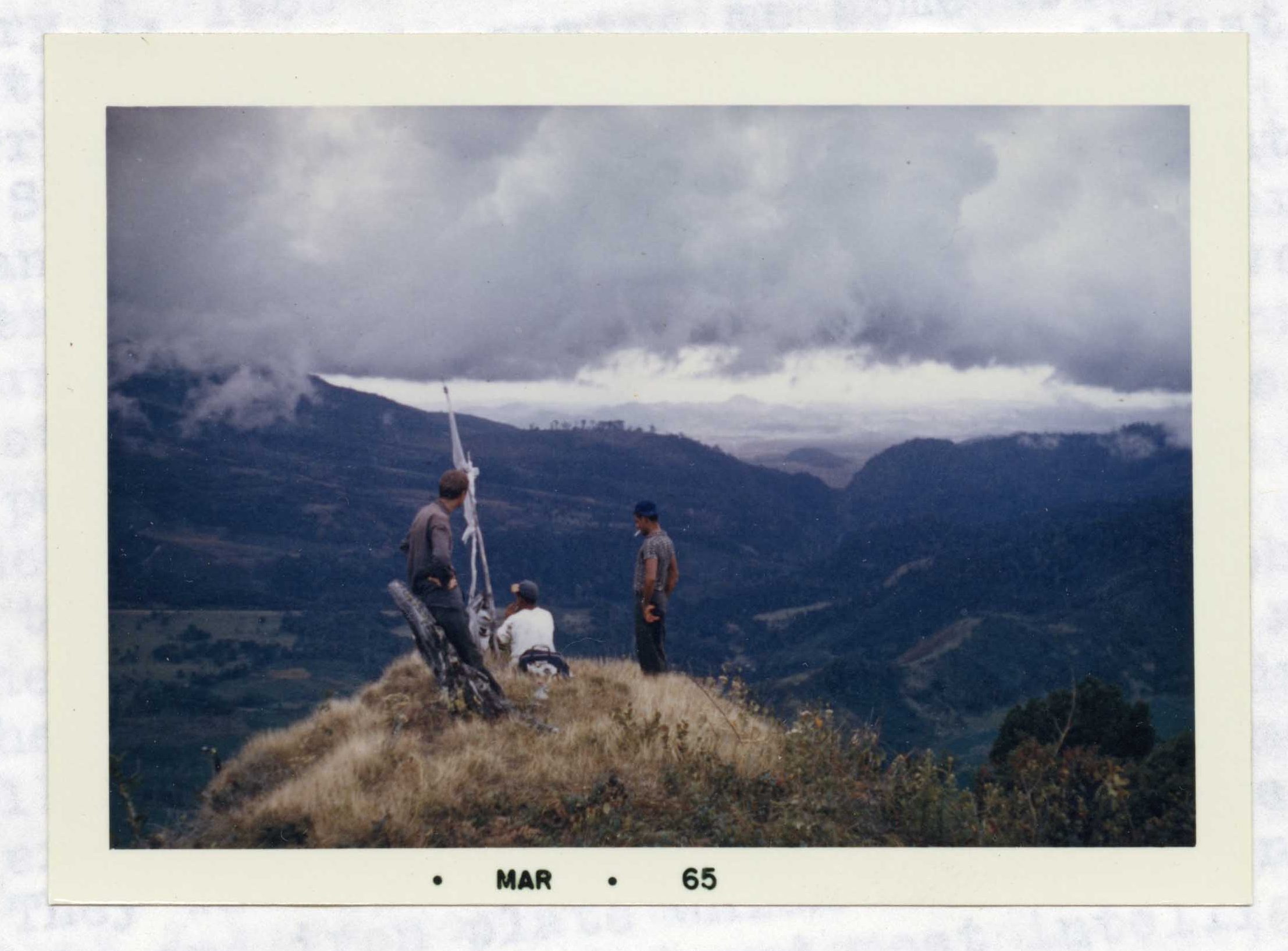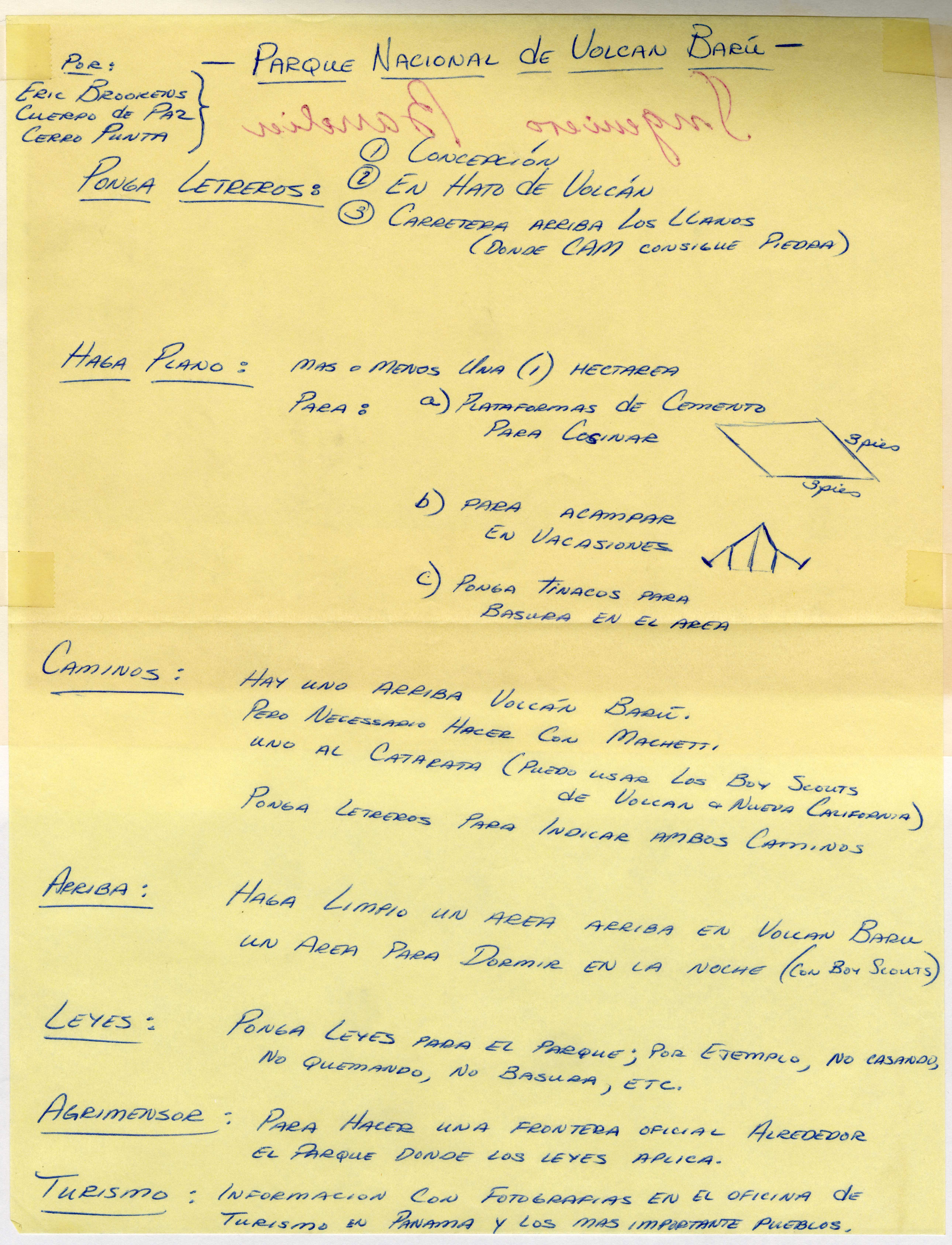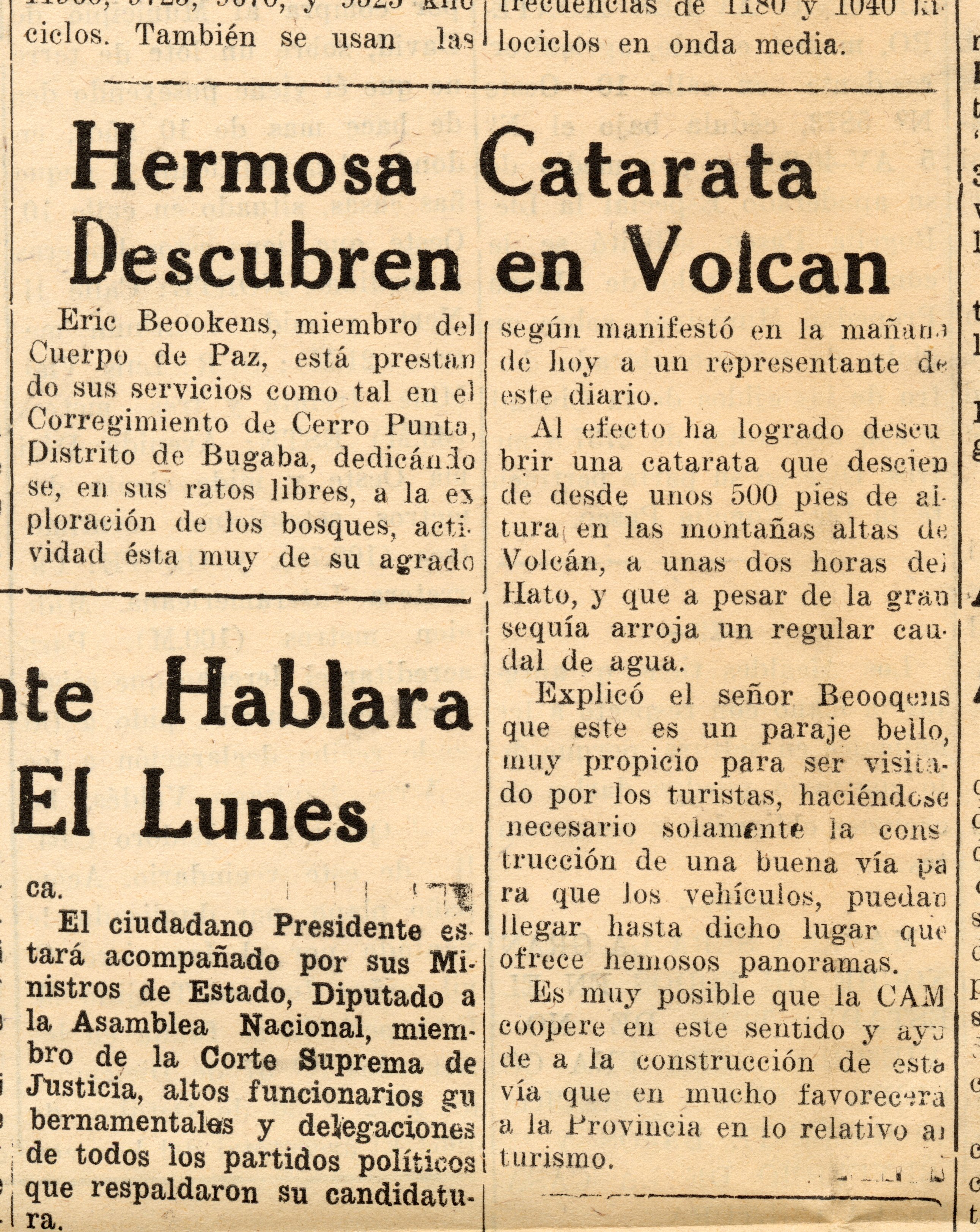Eric Brookens joined the Peace Corps in 1964, where he served in Panama on the Rural Community Development and Agriculture Cooperative project. He lived in Cerro Punta, Chiriqui Province—a mountain village 6,000 feet within the mountains of Volcán Barú. During his service, Brookens painted houses, assembled English classes, constructed a school, ran a local summer youth camp, and worked with a potato surplus cooperative—among other things. A year after he arrived in Cerro Punta, Brookens and another PCV Duane got the idea to create a national park on Volcán Barú.

Photo taken atop the mountain Cerro Punta looking towards El Hato de Volcan and Cosa Rica in the far background, March 1965. Eric Brookens, Panama 1964-1966, Box 1, Peace Corps Community Archives, American University Library.
Brookens and Myklejord spent the spring and summer of 1965 exploring the mountain, collecting notes on the wildlife, vegetation, waterfalls, and volcanic craters at the summit. The U.S. Geological Survey measures Volcán Barú at 3,475 meters—the tallest mountain in Panama. The summit offers clear views of both the Pacific Ocean and Caribbean Sea on a clear day. After their hikes, Brookens jotted down five essentials to maintaining a successful national park: signs, flattened areas for camping, paved roads up the mountain, laws against burning and waste, establishing borders, and publicizing the park in tourist offices around Panama.
Plans for the park went public in May 1965, when Brookens traveled to David, the capital city of Chiriquí Province, to meet with Governor Sitton about the project. Pleased with the idea, Sitton introduced Brookens to the Engineer Manuel Barrelier, chief of CAM (an agency within Panama’s Public Works Ministry)—who had direct power over plans for a national park.

Notes for the National Park at Volcan Baru. Eric Brookens, Panama 1964-1966, Box 1, Peace Corps Community Archives, American University Library.
Brookens describes the meeting with Barrelier in his diary:
I presented the plan written out on the yellow sheet of paper, and between frequent interruptions he finally said that he thought he could work it out, but would like pictures of the planned areas and groups of people that might be willing to cooperate, such as the Boy Scouts. I told him I would try and work it out and return in a month or so to give him the pictures and a report on what I proposed. Everything seemed to be OK when I left, but I always try and cut myself from by too optimistic with the Panamanian government!
To bolster their proposal, the volunteers joined forces with local groups, including a tree conservation club, “Los Amigos del Arbol.” They also connected with the Forest Service, the Director of Land Reform, the Department of Agriculture, and the Smithsonian Institute in the Canal Zone. The proposal began:

“Hermosa Catarata Descubren en Volcan,” La Razon, May 6, 1965. Eric C. Brookens, Panama 1964-1966, Box 1, Peace Corps Community Archives, American University Library.
North America, during more than a hundred years of intensive exploration and settlement of the wilderness, ruthlessly destroyed several of the once numerous species of animal life and beautiful forest areas. Fortunately today, conservation has reversed the trend of diminishing wildlife and forests through the use of national parks…”
“After hiking extensively around the area, seeing its wildlife, thick vegetation, a 400 foot waterfall, numerous extinct Volcanic craters at its top, and overall natural beauty; we want to present the thought to the Panamanian people of forming their first national park.
Brookens submitted a proposal to Barrelier in December 1965, with suggested steps to attract tourists and get the area ready for camping and hiking.
Plans for the park began to falter during the winter of 1965-1966 as Panamanian interest waned and the volunteers became involved with other projects. Brookens and Myklejord continued to hike the mountain, and used it for activities during a youth camp in February 1966. By their termination of service in July, plans for the national park had fallen by the wayside; however, Volcán Barú did acquire national park status in 1976. In 2008, the U.S. Geological Survey reported that the volcano is still active and expected to erupt again “in the near or distant future.”
References:
David R. Sherrod, James W. Vallance, Arkin Tapia Espinoza, and John P. McGeehin, “Volcán Barú: Eruptive History and Volcano-Hazards Assessment,” 2008. (Accessed March 2, 2020). https://pubs.usgs.gov/of/2007/1401/
“Barú”. Global Volcanism Program. Smithsonian Institution. (Accessed March 2, 2020) https://volcano.si.edu/volcano.cfm?vn=346010
“Baru Volcano National Park”. (Accessed March 2, 2020) https://www.anywhere.com/panama/attractions/baru-volcano-national-park
Eric Brookens, Cooperative Quarterly Report #5, March 15, 1966. Eric Brookens, Panama 1964-1966, Box 1, Peace Corps Community Archives, American University Library.
Eric Brookens’ Diary, May 6, 1965. Eric Brookens, Panama 1964-1966, Box 1, Peace Corps Community Archives, American University Library.
Eric Brookens’ Diary, May 7, 1965. Eric Brookens, Panama 1964-1966, Box 1, Peace Corps Community Archives, American University Library.
Eric Brookens, “Termination Report,” c. 1966. Eric Brookens, Panama 1964-1966, Box 1, Peace Corps Community Archives, American University Library.
Eric Brookens, “The Peace Corps,” article, c. 1965. Eric Brookens, Panama 1964-1966, Box 1, Peace Corps Community Archives, American University Library.
“Hermosa Catarata Descubren en Volcan,” La Razon, May 6, 1965. Eric C. Brookens, Panama 1964-1966, Box 1, Peace Corps Community Archives, American University Library.
“Sugieren Construir un Parque Nacional en el Volcan Baru,” Clipping from Panama newspaper, 1966. Eric Brookens, Panama 1964-1966, Box 1, Peace Corps Community Archives, American University Library.
United States. Central Intelligence Agency. “Daily Report, Foreign Radio Broadcasts, Issues 161-165,” August 16, 1968. M1
